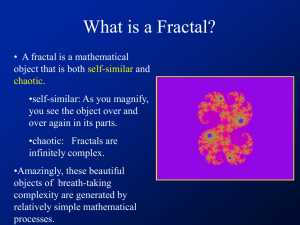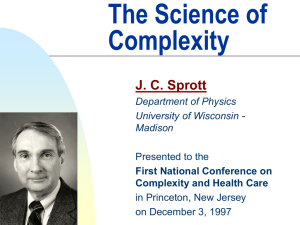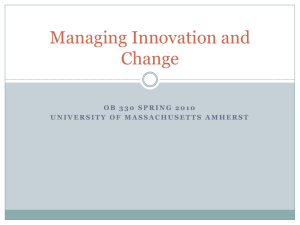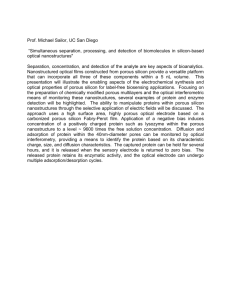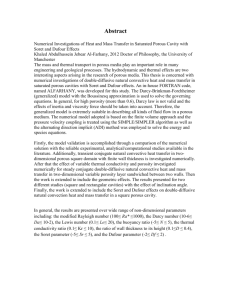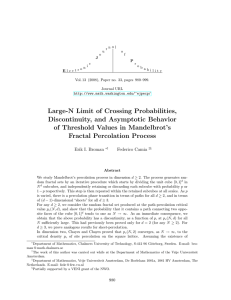Complex Systems Lecture: Introduction Tomáš Fürst 1. "I think the
advertisement
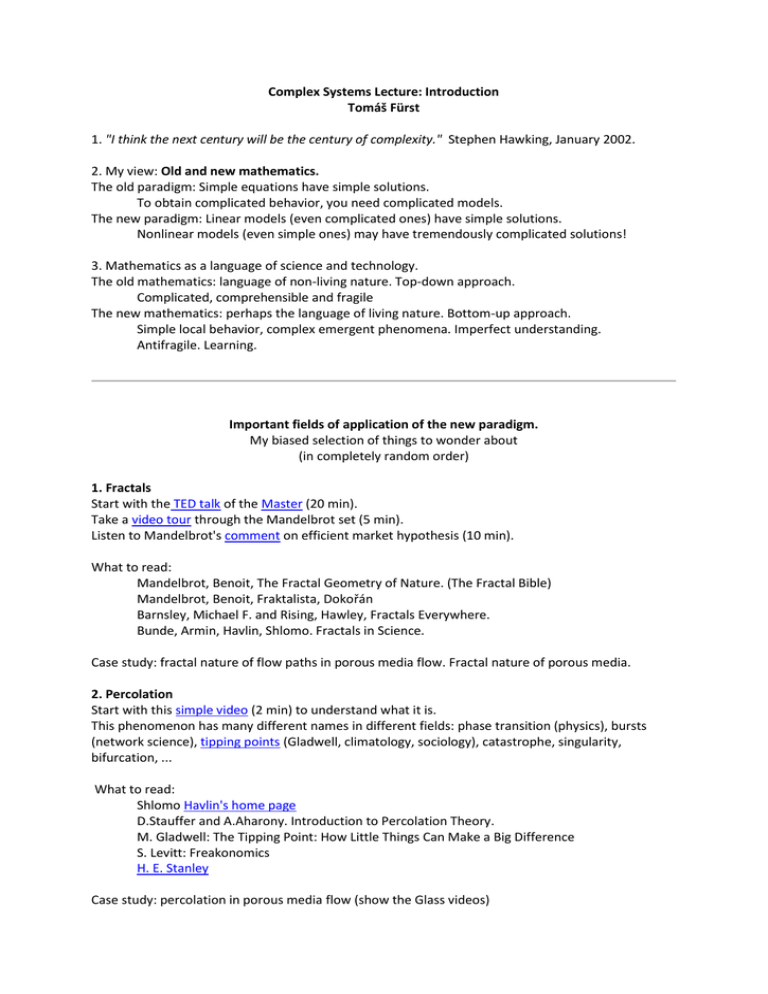
Complex Systems Lecture: Introduction Tomáš Fürst 1. "I think the next century will be the century of complexity." Stephen Hawking, January 2002. 2. My view: Old and new mathematics. The old paradigm: Simple equations have simple solutions. To obtain complicated behavior, you need complicated models. The new paradigm: Linear models (even complicated ones) have simple solutions. Nonlinear models (even simple ones) may have tremendously complicated solutions! 3. Mathematics as a language of science and technology. The old mathematics: language of non-living nature. Top-down approach. Complicated, comprehensible and fragile The new mathematics: perhaps the language of living nature. Bottom-up approach. Simple local behavior, complex emergent phenomena. Imperfect understanding. Antifragile. Learning. Important fields of application of the new paradigm. My biased selection of things to wonder about (in completely random order) 1. Fractals Start with the TED talk of the Master (20 min). Take a video tour through the Mandelbrot set (5 min). Listen to Mandelbrot's comment on efficient market hypothesis (10 min). What to read: Mandelbrot, Benoit, The Fractal Geometry of Nature. (The Fractal Bible) Mandelbrot, Benoit, Fraktalista, Dokořán Barnsley, Michael F. and Rising, Hawley, Fractals Everywhere. Bunde, Armin, Havlin, Shlomo. Fractals in Science. Case study: fractal nature of flow paths in porous media flow. Fractal nature of porous media. 2. Percolation Start with this simple video (2 min) to understand what it is. This phenomenon has many different names in different fields: phase transition (physics), bursts (network science), tipping points (Gladwell, climatology, sociology), catastrophe, singularity, bifurcation, ... What to read: Shlomo Havlin's home page D.Stauffer and A.Aharony. Introduction to Percolation Theory. M. Gladwell: The Tipping Point: How Little Things Can Make a Big Difference S. Levitt: Freakonomics H. E. Stanley Case study: percolation in porous media flow (show the Glass videos) 3. Synchronisation Watch this beautiful BBC video to see how Nature sees it (3 min). Listen to the TED talk of the mathematical founding father Steve Strogatz (20 min) Read one of my blogs titled 'Světlušky, larvy, hadi ...' You may be surprised to hear that epilepsy is a code name for synchronization. Human heart is another example. What to read: Strogatz, Steven (2003). Sync : the emerging science of spontaneous order. Case study: Porous media: oscillation phenomena in discharge under homogeneous influx boundary conditions (Pražák and Šír). 4. Epidemiology Network science has brought a revolution in epidemiology. From ODEs to PDEs to SDEs and now to stochastic processes on networks. See the TED talk (20 min) of the founder of network science Albert Laszlo Barabasi on epidemiology. See a short interview (3 min) with Alessandro Vespigniani on YouTube. Meet Dirk Brockmann (a great inspiration for this course) on YouTube. See his simulation. What to read: Barrat, A., Barthelemy, M. , Vespignani, A. (2008). Dynamical processes on complex networks. Barabasi AL, Linked. Barabasi AL, Bursts. There is an update regarding the Ebola outbreak. 5. Neural Networks, Machine Learning and Artificial intelligence This course should NOT be about any of those, there is another course for that. 6. Cellular Automata Maybe the first glimpse of complex systems, goes back to JvN, S. Ulam, N. Wiener, R. Feynmann. Get an idea of how complicated behavior emerges from super-simple local rules: Chris Langton and his ant rule. Almost all of the questions are open. Close link to percolation. Listen to the TED talk (20 min) of the contraversial, much-hated, self-adoring Steve Wolfram. What to read: Wolfram, Stephen (2002). A New Kind of Science. von Neumann, John, 1966, The Theory of Self-reproducing Automata. Chopard, Droz: Cellular automata modelling of complex systems. Rothman, Zaleski: Lattice gas cellular automata. Case study: Navier Stokes equations and LGCA, porous media flow alternative models. 7. Pattern formation (or self-organisation) Explore the Scott-Gray model to get a feeling of what is going on. Go through the fascinating history of Belousov-Zabotinsky reactions, see this YouTube video (2min). Link this to the introduction about old and new mathematics. Check out also Rayleigh-Benard convection for a really old and well exploited example of pattern formation. What to read: A. Bejan (2000), Shape and Structure, from Engineering to Nature Stuart Kauffman (1993), Origins of Order: Self-Organization and Selection in Evolution Prigogine, I., & Stengers, I. (1984). Order out of chaos: Man’s new dialogue with nature Case study: pattern formation in porous media flows. 8. Self-organized criticality (SOC) This maybe the only good theory we have for non-linear far-from-equilibrium systems. It connects earthquakes, extinction of species, economic time series, Electro Cardio Graphy, Zipf's Law, and many others. Check out Didier Sornette on TEDtalks. This is a short wiki page about The Prophet. This is an old article of mine about SOC and the European debt crisis (see who was right!). What to read: Per Bak (1996), How Nature Works: The Science of Self-Organized Criticality, Didier Sornette 9. Chaos (Theory) This course should NOT be about chaos theory (unless you insist), there are other courses for that (I hope). To get a feeling for what is going on, explore the celebrated Lorenz attractor. This wiki article provides much better introduction than all the Czech texts I have seen so far. What to read: James Gleick, Chaos: Making a New Science, New York: Penguin, 1988 (The best popular intro, good Czech translation) Ian Stewart, Does God Play Dice? Li, T.Y.; Yorke, J.A. (1975). "Period Three Implies Chaos" Strogatz, Steven (2000). Nonlinear Dynamics and Chaos. (The most widely read textbook) R. Highfiels, P. Coveney: Frontiers of Complexity: The Search for Order in a Chaotic World (Fascinating, there is a very good Czech translation) Case study: porous media flow, sensitivity to initial conditions. 10. New Economics In Britain, there are student protests that demand that the Universities stop teaching the old failed economics and start anew! The Institute for New Economic Thinking. What are our students doing? Old economic thinking: Paul Samuelson and his equilibrium thermodynamics in disguise. New economic thinking: The Austrian school resurection. Read the Nobel lecture from 1974! Check out Thermo-economics and Econo-physics. What to read: P. Corning: Thermoeconomics: Beyond the second law (Ingenious text) Buchanan: What has econophysics done for us? Eugene Stanley (60 min videolecture) Rosario N. Mantegna, H. Eugene Stanley, An Introduction to Econophysics: Correlations and Complexity in Finance, Nassim Taleb: Black Swan. Nassim Taleb: Antifragile Didier Sornette: TED talk (17 min), his new book in my office Case study: this has nothing to do with porous media but everything to do with the disaster of 2007. You may look at my blogs or my contributions to FinMag. 11. Statistical physics itself. This course will NOT be about statistical physics. There should be some course on statphys on UP but it is not the case. Non-equilibrium thermodynamics and statphys is just about the most important tool for understanding Nature in its complexity. 12. The network revolution Beneath the surface of many of the complex phenomena, there are often networks. This course might be (at least in part) about networks. Two principal sources for this topic: Mark E Newman: Networks, An Introduction. (I have a copy). Shlomo Havlin and Reuven Cohen: Complex Networks. (can be dowloaded). There are several topics connected to complex networks that can be covered: A. Examples of complex networks: Internet, telephone network, power grids, transportation networks, WWW, social networks, citation networks, gene regulatory networks, metabolic networks, food webs, neural networks. B. The structure of networks This is some good old (mostly linear) algebra in disguise. Much of this goes under the name of graph theory. A nice new interpretation of good old mathematics. C. Evolution of networks. The path from good old Erdos-Renyi models (1950s) to the groundbreaking work of Barabasi. A.-L. Barabási, R. Albert ,Emergence of scaling in random networks , Science 286, 509–512 (1999) one of the most cited articles ever. D. Networks algorithms. Searching back and forth. This maybe beyond the scope of this course and will nicely into an Optimization course. E. Processes on networks. Back to percolation, epidemics, synchronization, ... all of the above on networks. Some of this will be covered Random sources and links Follow the links for the particular topics above. Read wikipedia and follow the hyperlinks. Model thinking class on coursera. Complex systems in social science. Elementary, intelligent and funny. Should be compulsory for all social scientists. The list of the most important courses around the world: http://www.santafe.edu/cscourses/ An amazing guy in statistical physics to follow: Cosma Shalizi http://www.stat.cmu.edu/~cshalizi/462/syllabus.html 13. And now for something completely different David MacKay: Information Theory, Inference, and Learning Algorithms. A few remarks about the ongoing revolution in statistics. Economics has been damaged beyond repair by wrong incentives and inappropriate statistics. Right now, this is happening in (soft) natural sciences. Let's start by learning to do inference right! David MacKay on videolectures. There is a Bayesian seminar each Tuesday!



